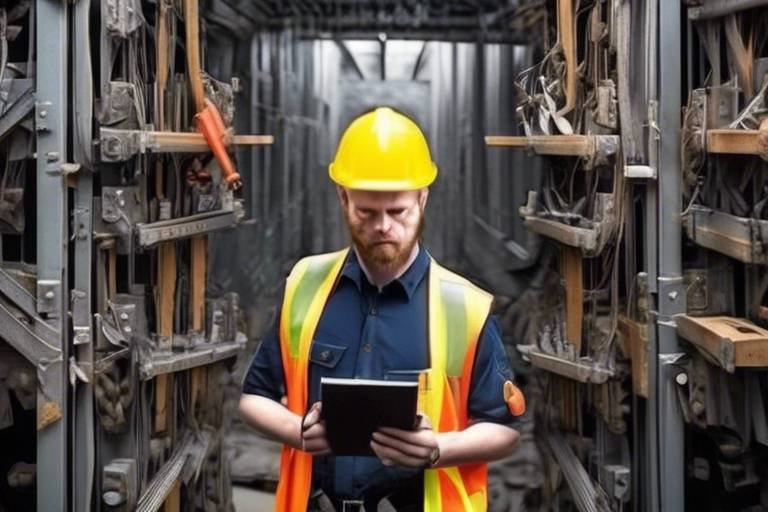An Ounce of Safety Measures - How it’s Related to Human Behavior?
In today's fast-paced world, the concept of safety is more critical than ever. Yet, have you ever wondered why some people diligently follow safety protocols while others seem oblivious? This article explores the intricate relationship between safety measures and human behavior, emphasizing the importance of understanding the psychological factors that influence safety practices in various environments. By delving into the depths of human psychology, we can uncover the reasons behind our actions—or lack thereof—when it comes to safety.
Safety is not just about rules and regulations; it's about the mindset and attitudes of individuals. Each person brings their unique experiences, beliefs, and perceptions to the table, which can significantly impact how they respond to safety measures. For example, consider a workplace where safety gear is mandatory. Some employees may view it as a nuisance, while others see it as a necessary precaution. This disparity often stems from underlying psychological factors, including cognitive biases and risk perception. Understanding these elements can help organizations tailor their safety strategies to align with human behavior.
Furthermore, the environment plays a pivotal role in shaping our actions. The physical and social surroundings can either encourage or discourage adherence to safety protocols. For instance, a well-organized workspace with visible safety signs and reminders can enhance compliance, while a cluttered area may lead to neglect. Similarly, social factors, such as peer behavior and community norms, can significantly influence individual choices regarding safety. When people observe their peers taking safety seriously, they are more likely to follow suit, creating a ripple effect that promotes a culture of safety.
In conclusion, the relationship between safety measures and human behavior is complex and multifaceted. By understanding the psychological aspects, environmental influences, and social norms surrounding safety, we can develop more effective strategies that resonate with individuals on a personal level. As we navigate the challenges of ensuring safety in various contexts, it becomes clear that an ounce of prevention is indeed worth a pound of cure.
- Why do some people ignore safety measures?
People may ignore safety measures due to cognitive biases, lack of awareness, or previous experiences that lead them to underestimate risks. - How can organizations improve safety compliance?
Organizations can improve compliance by fostering a strong safety culture, providing effective training, and ensuring clear communication. - What role does peer influence play in safety behavior?
Peer influence can significantly motivate individuals to adhere to safety measures, as people often look to their social circles for cues on appropriate behavior. - How can community initiatives enhance safety awareness?
Community-driven initiatives can raise awareness, promote engagement, and create a shared responsibility for safety among community members.

The Psychology of Safety
Understanding the psychological aspects of safety is crucial for unraveling why some individuals diligently adhere to safety measures while others tend to neglect them. It's fascinating how our minds work in relation to safety. For instance, have you ever wondered why two people can be in the same hazardous situation, yet one follows all the safety protocols while the other takes unnecessary risks? This discrepancy often boils down to cognitive biases and individual risk perception, which are deeply rooted in our psychology.
Cognitive biases, such as the optimism bias, can lead individuals to underestimate the likelihood of experiencing negative outcomes. This bias makes people feel invincible, convinced that accidents happen to others but not to them. Imagine walking on a tightrope; if you think you won't fall, you're likely to take more risks, like not using a safety harness. On the other hand, when people are more aware of potential risks, they tend to take safety measures more seriously.
Moreover, our risk perception can be influenced by various factors including personal experiences, cultural background, and even media portrayals of safety incidents. For example, if someone has experienced a workplace accident, their perception of risk may be heightened, leading them to prioritize safety measures more than someone who hasn’t had such experiences. This highlights the importance of context in shaping our behaviors. A person’s environment can act as a mirror reflecting their attitudes towards safety.
Another critical aspect to consider is the emotional response to safety measures. Fear can be a powerful motivator. When individuals feel threatened by a potential danger, they are more likely to comply with safety protocols. However, excessive fear can lead to anxiety, which may cause individuals to avoid situations altogether rather than engage in safe practices. Striking a balance between awareness of risks and managing fear is essential for promoting a culture of safety.
In addition to cognitive biases and emotional responses, social influences also play a significant role in safety behavior. People often look to their peers for cues on how to behave. If someone sees their colleagues ignoring safety protocols, they may feel pressured to do the same, regardless of their personal beliefs about safety. This phenomenon underscores the importance of fostering a strong safety culture within organizations, where adherence to safety measures is the norm rather than the exception.
To summarize, the psychology of safety is a complex interplay of cognitive biases, risk perception, emotional responses, and social influences. Understanding these factors is essential for developing effective safety protocols and training programs that resonate with individuals on a personal level. By addressing the psychological barriers to safety, organizations can create environments where safety is not just a set of rules, but a shared value embraced by everyone.
- What is the optimism bias? The optimism bias is a cognitive bias that leads individuals to believe that they are less likely to experience negative events compared to others.
- How can emotional responses affect safety behavior? Emotional responses like fear can motivate individuals to comply with safety measures, but excessive fear may lead to avoidance of situations altogether.
- Why is social influence important in safety compliance? People often look to their peers for behavioral cues, so a strong safety culture can encourage adherence to safety measures.

When we think about safety, it's easy to overlook the profound impact our surroundings have on our behavior. The environment, both physical and social, acts as a silent conductor, orchestrating how we react to safety measures. Imagine walking into a workplace where safety gear is not just recommended but visibly worn by everyone around you. It creates a sense of normativity, doesn’t it? This phenomenon is known as the social influence of environment, and it plays a pivotal role in how we perceive and adhere to safety protocols.
To understand this influence better, we need to break it down into two main categories: the physical environment and the social environment. The physical environment includes the layout of a space, the availability of safety equipment, and even the cleanliness of an area. For instance, a cluttered workspace can lead to accidents simply because it’s harder to navigate safely. On the other hand, a well-organized environment promotes a sense of safety and encourages individuals to follow safety protocols. Think of it like a well-tended garden; when everything is in its place, it flourishes, just as a safe environment fosters better safety behavior.
The social environment, however, encompasses the relationships and interactions we have with others. It’s about the culture of the workplace and how safety is prioritized among peers. If employees see their colleagues taking shortcuts or ignoring safety measures, they may feel pressured to do the same. This is where the concept of peer influence comes into play. When individuals observe others neglecting safety, they may subconsciously decide that such behavior is acceptable, leading to a broader culture of non-compliance.
Moreover, the influence of environment can also be quantified. Research has shown that environments designed with safety in mind can reduce accidents significantly. For example, workplaces that implement clear signage, proper lighting, and accessible safety equipment tend to have fewer incidents. Here’s a quick look at some of the environmental factors that can affect safety behavior:
| Environmental Factor | Impact on Safety Behavior |
|---|---|
| Cluttered Spaces | Increases risk of accidents and injuries |
| Proper Signage | Enhances awareness and compliance with safety protocols |
| Lighting | Improves visibility, reducing the likelihood of accidents |
| Safety Equipment Availability | Encourages usage and adherence to safety measures |
In conclusion, the environments we inhabit play a crucial role in shaping our safety behaviors. By fostering a supportive and safety-oriented atmosphere, we can significantly enhance compliance with safety measures. It’s about creating a culture where safety is not just an obligation but a shared value. So, the next time you step into an environment, take a moment to assess how it influences your behavior. Are the surroundings encouraging safe practices, or are they silently promoting risk?
- How does a cluttered environment affect safety? A cluttered environment can lead to accidents due to obstacles and distractions, making it difficult to navigate safely.
- What role does peer influence play in safety compliance? Peer influence can encourage or discourage adherence to safety measures based on the behavior of those around us.
- Can workplace design improve safety? Yes, a well-designed workplace with clear signage, proper lighting, and accessible safety equipment can significantly reduce accidents.

When we talk about workplace safety culture, we're diving into the very essence of how safety is perceived and practiced within an organization. Imagine a workplace where safety is not just a set of rules, but a way of life—a culture that permeates every level of the organization. This culture is cultivated through the collective attitudes, beliefs, and behaviors of everyone involved, from top management to entry-level employees. It’s like a garden; if nurtured properly, it flourishes, but if neglected, it withers away.
At the heart of a strong safety culture lies effective leadership. Leaders set the tone for safety practices by demonstrating a commitment to safety in their actions and decisions. When leaders prioritize safety, it sends a powerful message to employees that their well-being is valued. This can be further enhanced through regular safety meetings, open-door policies for discussing safety concerns, and by recognizing and rewarding safe behaviors. For instance, a simple acknowledgment of an employee who reports a near-miss incident can reinforce the idea that safety is a shared responsibility.
Employee engagement is another crucial component of a robust safety culture. When employees feel involved in safety discussions and decisions, they are more likely to take ownership of their actions and adhere to safety protocols. Organizations can foster this engagement by:
- Encouraging employees to participate in safety committees.
- Soliciting feedback on safety practices and policies.
- Providing opportunities for employees to lead safety training sessions.
Moreover, a culture of safety thrives in an environment where communication is clear and effective. Open lines of communication allow for the free flow of information regarding safety hazards and practices. This is where training and education come into play. Regular training sessions not only equip employees with essential safety knowledge but also reinforce the idea that safety is a priority. When employees understand the risks associated with their tasks and the proper safety measures to mitigate those risks, they are more likely to act safely.
In summary, a strong workplace safety culture is built on the foundation of engaged leadership, active employee participation, and clear communication. When these elements come together, they create an environment where safety is not just an afterthought but an integral part of the workplace ethos. This kind of culture not only protects employees but also enhances productivity and morale, ultimately leading to a more successful organization.

When it comes to safety, training and education are not just buzzwords; they are the backbone of a safe environment. Imagine a world where every individual is equipped with the knowledge and skills to recognize hazards and respond appropriately. This is the essence of effective training programs. They serve as a bridge, connecting theoretical safety knowledge with practical application. But what makes training truly effective? It’s all about engaging the participants and making the content relatable.
One of the most powerful methods of training involves hands-on experience. For instance, simulations that mimic real-life scenarios can significantly enhance learning. Participants are not just passive listeners; they become active problem solvers, which leads to better retention of safety practices. According to studies, individuals who undergo practical training are more likely to remember and apply safety measures in their daily routines.
Moreover, the use of technology in training cannot be overlooked. Online modules, interactive videos, and virtual reality experiences can make learning about safety more engaging. For example, an organization might implement a virtual reality training program that immerses employees in a hazardous situation, allowing them to practice their responses in a safe environment. This not only boosts their confidence but also ensures that they are well-prepared for real-life situations.
To further illustrate the impact of training, consider the following table that outlines key training methods and their benefits:
| Training Method | Benefits |
|---|---|
| Hands-On Training | Enhances retention through practical application |
| Online Learning | Flexible and accessible; allows self-paced learning |
| Simulation Exercises | Provides realistic practice in a controlled environment |
| Workshops and Seminars | Encourages interaction and discussion among participants |
Additionally, it’s crucial to tailor training programs to fit the specific needs of the organization and its employees. This means considering factors such as job roles, the nature of risks involved, and the existing safety culture. For instance, a construction company might focus on fall protection training, while a laboratory might prioritize chemical safety protocols. By customizing training, organizations can ensure that their employees are not just compliant but genuinely understand the importance of safety in their unique contexts.
In conclusion, effective training and education are essential for fostering a culture of safety in any environment. By investing in comprehensive training programs that incorporate hands-on experiences, technology, and tailored content, organizations can empower their employees to prioritize safety. After all, a well-informed workforce is the first line of defense against accidents and hazards.
- What is the importance of safety training? Safety training is vital as it equips employees with knowledge and skills to prevent accidents and respond effectively to emergencies.
- How often should safety training be conducted? Safety training should be conducted regularly, ideally at least once a year, or whenever there are changes in procedures or equipment.
- Can online training be as effective as in-person training? Yes, online training can be effective, especially when it includes interactive components and real-world scenarios.
- What role does leadership play in safety training? Leadership is crucial in promoting a culture of safety; their commitment to training encourages employee participation and compliance.

Effective communication is the backbone of any successful safety initiative. When it comes to safety measures, how we convey information can significantly influence behavior and compliance. Imagine trying to navigate a maze blindfolded; without clear directions, you’re likely to stumble and fall. Similarly, in the realm of safety, if individuals are not properly informed or if the information is unclear, the risk of accidents increases dramatically.
One of the most critical aspects of communication strategies is the clarity of the message. It’s not just about what is communicated, but how it’s delivered. For instance, using simple language and avoiding jargon can make safety protocols more accessible to everyone, regardless of their background or experience. Visual aids, such as infographics and posters, can also play a vital role in enhancing understanding. These tools can simplify complex information, making it easier for individuals to grasp essential safety practices quickly.
Additionally, the timing and frequency of communication are crucial. Safety messages should not be a one-off announcement; they need to be repeated and reinforced regularly. This can be achieved through various channels, such as:
- Safety meetings
- Newsletters
- Digital platforms (e.g., emails, intranet)
- Visual reminders (e.g., safety signs, bulletin boards)
Moreover, fostering an open dialogue about safety can encourage individuals to voice their concerns and share their experiences. When employees feel comfortable discussing safety issues, it creates a culture of transparency and trust. This can be further enhanced by implementing feedback mechanisms, such as anonymous suggestion boxes or regular surveys, allowing individuals to contribute to safety discussions without fear of repercussion.
Lastly, tailoring communication strategies to the audience is essential. Different groups may have varying levels of understanding and engagement with safety practices. For instance, new employees might require more detailed training compared to seasoned workers. Adapting your approach to fit the audience's needs can lead to more effective communication and, ultimately, better adherence to safety measures. It’s all about creating a cohesive environment where safety is prioritized and everyone feels involved in the process.
Q1: Why is communication important in safety measures?
A1: Communication is vital because it ensures that everyone understands safety protocols and the reasons behind them. Clear communication can prevent misunderstandings that may lead to accidents.
Q2: What are effective methods for communicating safety protocols?
A2: Effective methods include using simple language, visual aids, regular updates, and fostering an open dialogue. Tailoring communication to the audience's needs also enhances understanding.
Q3: How can feedback improve safety communication?
A3: Feedback mechanisms allow individuals to share their concerns and suggestions, promoting a culture of safety and continuous improvement. This can lead to better compliance and awareness of safety practices.
Q4: How often should safety communications occur?
A4: Safety communications should be ongoing and regular. Frequent reminders through various channels help reinforce the importance of safety measures and keep them top of mind for everyone.

When we think about safety, it’s easy to assume that people will always make the right choices if they’re informed about the risks. However, the reality is often more complex. Behavioral economics dives deep into the interplay between our economic decisions and our behavior, shedding light on why people sometimes ignore safety measures even when they know better. Imagine standing at a crossroads: one path leads to safety, while the other tempts you with convenience or immediate gratification. Which one do you choose? This dilemma is where behavioral economics comes into play.
One of the key concepts in behavioral economics is the idea of incentives. These can be positive or negative, and they significantly influence our choices. For example, if an employer offers a bonus for employees who consistently follow safety protocols, it creates a positive incentive to adhere to those measures. Conversely, if there are penalties for non-compliance, it can serve as a deterrent. Understanding these dynamics can help organizations design better safety programs that encourage compliance.
Moreover, our perception of risk plays a crucial role in how we respond to safety measures. People often underestimate the likelihood of accidents, believing that “it won’t happen to me.” This cognitive bias leads to a dangerous complacency. To combat this, safety programs need to address these misconceptions. For instance, using real-life examples and statistics can help paint a clearer picture of the potential dangers, making the risks feel more tangible and immediate.
In addition to incentives, defaults also play a significant role in shaping behavior. When safety measures are presented as the default option, individuals are more likely to stick with them. For example, if a company automatically enrolls employees in safety training programs, rather than requiring them to opt-in, participation rates tend to increase. This simple shift can lead to a more safety-conscious culture without requiring much effort from the employees.
Another fascinating aspect of behavioral economics is the concept of loss aversion. Research shows that people are more motivated to avoid losses than to achieve gains. This insight can be leveraged in safety campaigns by emphasizing what individuals stand to lose if they don’t adhere to safety measures. For example, highlighting the potential health risks or financial consequences of ignoring safety protocols can create a sense of urgency and encourage compliance.
To summarize, behavioral economics provides valuable insights into how economic factors and human psychology influence safety behavior. By understanding the motivations behind our choices, organizations can create more effective safety programs that not only inform but also engage individuals. The challenge lies in transforming knowledge into action, and that’s where the principles of behavioral economics can make a significant impact.
- What is behavioral economics?
Behavioral economics is a field of study that examines how psychological factors affect economic decision-making, particularly in the context of human behavior and safety. - How can incentives improve safety compliance?
Incentives can motivate individuals to adhere to safety measures by offering rewards for compliance or penalties for non-compliance, thus influencing their behavior positively. - What role does risk perception play in safety behavior?
Risk perception affects how individuals assess potential dangers, often leading to complacency if they believe they are not at risk, which can result in neglecting safety practices. - How can organizations use loss aversion to promote safety?
By emphasizing the potential losses associated with unsafe practices, organizations can create a sense of urgency that encourages individuals to comply with safety measures.

When we think about safety compliance, it’s easy to focus solely on the rules and regulations that govern our behaviors. However, there’s a powerful undercurrent that shapes how we approach safety: social norms. These unwritten rules, which dictate what is considered acceptable behavior within a group, can significantly influence our adherence to safety measures. Have you ever noticed how people tend to follow the lead of those around them? That’s the essence of social norms at play!
Social norms can be both positive and negative. For instance, if a workplace has a culture where everyone wears their safety gear, new employees are likely to adopt this behavior simply to fit in. Conversely, if they observe coworkers neglecting safety protocols, they might feel compelled to do the same, rationalizing that “if everyone else is doing it, it must be okay.” This phenomenon highlights the dual-edged sword of social influence—while it can promote safety, it can just as easily undermine it.
Research has shown that individuals are often motivated by the desire to conform to the expectations of their peers. A study conducted in various workplaces revealed that employees were significantly more likely to follow safety protocols when they believed their colleagues were also compliant. In contrast, when they perceived that others were lax about safety, their own compliance suffered. This brings us to an important question: how can we leverage social norms to enhance safety compliance?
To harness the power of social norms, organizations can implement strategies that promote positive behaviors. Here are a few effective approaches:
- Role Modeling: Encourage leaders and influential employees to consistently demonstrate safe behaviors. When others see respected figures prioritizing safety, they are more likely to follow suit.
- Peer Recognition: Create programs that recognize and reward individuals or teams for their commitment to safety. This not only reinforces positive behavior but also sets a standard for others to aspire to.
- Open Communication: Foster an environment where employees feel comfortable discussing safety concerns and sharing best practices. When people engage in conversations about safety, it reinforces its importance within the group.
Moreover, community engagement plays a vital role in shaping safety norms beyond the workplace. When communities come together to promote safety initiatives—be it through neighborhood watch programs, local safety workshops, or public awareness campaigns—they create a collective expectation around safe behaviors. This communal approach not only strengthens social norms but also builds a sense of accountability among members.
Ultimately, understanding the impact of social norms on safety compliance is crucial for any organization aiming to enhance its safety culture. By recognizing the influence of peer behavior and community standards, we can create environments that not only encourage compliance but also foster a genuine commitment to safety. So, the next time you’re in a situation where safety is a concern, consider the power of those around you. Are they setting a positive example? If not, how can you be the change that inspires others to prioritize safety?
- What are social norms?
Social norms are the unwritten rules that govern behavior within a group, influencing how individuals act in various situations. - How do social norms affect safety compliance?
Social norms can encourage or discourage adherence to safety measures based on the behaviors observed within a group. - What strategies can promote positive safety norms?
Effective strategies include role modeling, peer recognition, and fostering open communication about safety practices. - Why is community engagement important for safety?
Community engagement helps establish collective expectations around safety, reinforcing positive behaviors and accountability among members.

Have you ever noticed how your friends' actions can sway your own decisions? This phenomenon is particularly evident when it comes to safety behavior. Peer influence is a powerful force that can either encourage or discourage adherence to safety measures. Imagine walking into a workplace where everyone is wearing their safety gear diligently. The sight alone sends a strong message: “This is important.” Conversely, if you see colleagues neglecting safety protocols, it might make you think, “Maybe it’s not that big of a deal.” This is the essence of peer influence—it's like a social magnet that pulls us toward certain behaviors based on the actions of those around us.
Research shows that individuals are often motivated to comply with safety measures when they observe their peers doing the same. This is rooted in our innate desire to fit in and be accepted within a group. When safety behaviors are normalized among peers, they become part of the social fabric, making it easier for individuals to follow suit. It's like a ripple effect; one person's commitment to safety can inspire others to adopt similar practices, creating a culture of safety that benefits everyone.
However, the opposite is also true. If safety measures are disregarded by peers, it can lead to a dangerous mindset where individuals perceive safety protocols as optional rather than essential. This is especially concerning in high-risk environments, such as construction sites or laboratories, where the stakes are significantly higher. To combat this, organizations must actively promote a culture where safety is prioritized and celebrated. This can be achieved through various strategies:
- Role Modeling: Leaders and influential team members should consistently demonstrate safe behaviors.
- Group Discussions: Encouraging open conversations about safety can help reinforce its importance among peers.
- Recognition Programs: Acknowledging individuals or teams that exemplify safe practices can motivate others to follow suit.
It's also worth noting that the impact of peer influence isn't limited to formal settings. In everyday life, social circles can shape our understanding of what is considered safe behavior. For instance, if a friend consistently ignores seatbelt laws or engages in risky driving, it may desensitize you to the importance of these safety measures. Therefore, fostering a culture of safety within your social circles is crucial, as these informal environments can be just as influential as workplace settings.
In conclusion, peer influence plays a pivotal role in shaping safety behavior. By understanding and leveraging this influence, organizations and communities can create an environment where safety is not only a priority but also a shared value. Encouraging positive peer dynamics can lead to a collective commitment to safety that ultimately protects everyone involved.
- What is peer influence in safety behavior? Peer influence refers to the impact that individuals within a social group have on each other's decisions and behaviors regarding safety measures.
- How can organizations promote positive peer influence for safety? Organizations can promote positive peer influence by encouraging role modeling, facilitating discussions about safety, and recognizing safe behaviors among employees.
- Why is peer influence significant in high-risk environments? In high-risk environments, the consequences of neglecting safety measures can be severe. Positive peer influence can help ensure that safety protocols are taken seriously by all individuals involved.

Community engagement is a powerful catalyst for promoting safety initiatives. When individuals come together to address safety concerns, it creates a ripple effect that can significantly enhance compliance and awareness. Imagine a neighborhood where residents actively participate in safety programs; this collective effort not only fosters a sense of belonging but also instills a shared responsibility for each other's well-being. But how exactly does this work?
First and foremost, community engagement builds trust. When people feel connected to their community, they are more likely to participate in safety initiatives. This can be seen in various forms, from neighborhood watch programs to local safety workshops. For instance, a community that organizes regular safety meetings can discuss local hazards and develop strategies to mitigate them. This proactive approach not only educates residents but also empowers them to take action. It’s like a team sport; when everyone plays their part, the whole team benefits.
Moreover, the involvement of local organizations and businesses can amplify these efforts. When businesses contribute resources or expertise to safety initiatives, it enhances the overall impact. For example, a local hardware store might sponsor a safety fair, providing tools and materials for community members to learn about home safety. This collaboration not only promotes safety but also strengthens community ties. It’s a win-win situation, where everyone walks away feeling more secure and connected.
Another key aspect of community engagement in safety initiatives is the role of education. Educating community members about safety practices is crucial. Workshops, seminars, and even social media campaigns can effectively disseminate information. For example, a community could host a series of workshops on fire safety, teaching residents how to use fire extinguishers and create emergency plans. By equipping individuals with knowledge, they become more confident in their ability to handle emergencies, ultimately leading to safer environments.
Furthermore, community engagement encourages feedback and dialogue. When community members are invited to share their thoughts and experiences regarding safety, it fosters a culture of openness. This can be done through surveys, town hall meetings, or informal gatherings. Listening to the community's concerns not only helps identify potential safety issues but also allows for the development of targeted solutions. It’s akin to tuning into a radio station; when you find the right frequency, everything becomes clearer and more harmonious.
In conclusion, community engagement is vital for the success of safety initiatives. By building trust, fostering collaboration, educating residents, and encouraging open dialogue, communities can create a robust safety culture. It’s essential to recognize that safety is not just an individual responsibility but a collective one. When communities unite for a common cause, they not only enhance safety but also strengthen the bonds that hold them together. So, what can you do to engage your community in safety initiatives? Start by sparking conversations, organizing events, and encouraging participation. Together, we can create safer environments for everyone.
- What is community engagement in safety initiatives?
Community engagement in safety initiatives refers to the collective efforts of individuals and organizations within a community to promote safety awareness and practices. - How can I get involved in local safety initiatives?
You can get involved by attending community meetings, volunteering for safety programs, or collaborating with local organizations focused on safety. - Why is education important in safety initiatives?
Education empowers individuals with the knowledge and skills needed to respond effectively to safety concerns, enhancing overall community safety. - What role do businesses play in community safety?
Businesses can contribute resources, expertise, and sponsorships to safety initiatives, helping to create a safer community environment.
Frequently Asked Questions
- What are the key psychological factors that influence safety behavior?
The key psychological factors that influence safety behavior include cognitive biases, risk perception, and individual attitudes toward safety measures. Understanding these factors helps in identifying why some people may adhere to safety protocols while others neglect them. For instance, overconfidence can lead individuals to underestimate risks, while a strong understanding of potential hazards can promote safer practices.
- How does the environment affect safety compliance?
The environment plays a significant role in shaping safety behavior. Physical aspects, like the layout of a workspace, can either facilitate or hinder safe practices. Social environments, including peer influence and workplace culture, also impact how individuals perceive and respond to safety measures. When safety is prioritized in both physical and social environments, compliance tends to improve.
- What is the importance of workplace safety culture?
A strong workplace safety culture is crucial because it fosters an atmosphere where safety is valued and prioritized. Leadership plays a vital role in establishing this culture by modeling safe behaviors and encouraging employee engagement. When employees feel involved and responsible for safety, they are more likely to adhere to safety protocols, leading to a safer work environment overall.
- What training methods are most effective for promoting safety?
Effective training methods include hands-on workshops, simulations, and interactive learning experiences. These approaches not only enhance knowledge but also build confidence in applying safety measures. Regular refresher courses and assessments can also keep safety practices top-of-mind and ensure that employees remain compliant with updated safety protocols.
- How can communication strategies improve safety awareness?
Clear and open communication is essential for effective safety measures. Communication strategies like regular safety meetings, informative signage, and feedback mechanisms can significantly enhance awareness. When individuals feel comfortable discussing safety concerns, it fosters a culture of safety where everyone is engaged and informed.
- What role do incentives play in promoting safety behavior?
Incentives can be powerful motivators for promoting safety behavior. Positive reinforcement, such as rewards for safe practices, can encourage individuals to comply with safety measures. Conversely, disincentives, like penalties for unsafe behavior, can deter risky actions. Balancing these approaches can lead to a more comprehensive safety culture.
- How do social norms influence safety compliance?
Social norms significantly impact individual behavior regarding safety. People are often influenced by the behaviors of their peers and the expectations of their social circles. When safety is viewed as a collective responsibility, individuals are more likely to comply with safety measures to align with their group’s standards.
- What is the role of community engagement in safety initiatives?
Community engagement is essential for promoting safety measures because it fosters a sense of shared responsibility. Community-driven initiatives, such as safety workshops or awareness campaigns, can raise awareness and encourage compliance among individuals. When communities come together to prioritize safety, the impact is often more significant and long-lasting.



















